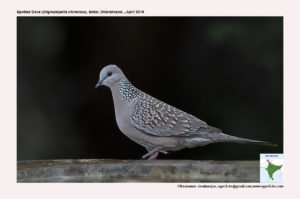Spotted Dove

Spotted Dove Stigmatopelia chinensis
Etymology:
- Stigmatopelia : Greek Word stigma- spot; peleia- dove
- Chinensis: From China
Vernacular Names: Hindi: Chitrokha/Chittidar fakhta, Parki, Chitta, Kangskiri, Panduk, Pun: Chini ghuggi, Bi: Kodaya panduk, Gond: Bode, Ben: Chhite ghughu, Telia ghughu, Ass: Pati kopou, Cachar: Daotu, Naga: Inruigu, Kuki: Voh kurup, Guj: Vana holi, Thaliyo holo, Mar: Thipkya kavada, Thipkedar Hola, Ta: Pulli pura, Mani pura, Umi pura, Te: Poda bellaguvva, Chukkala guvva, Mal: Chakkara kutta pravu, Aripravu, Kan: Chukki kapota, Sinh: Alu kobeyiya
Distribution in India: Widespread resident except for some parts of West and North Himalayas.
Description: Size of 28-30 cm. Forehead, crown and face are light grey with hints of pink; chin white to pale grey; nape, sides of upper neck, throat and breast is vinaceous pink merging into buff and grey on lower belly; a narrow black line extends from gape to eye; a patch of feathers on sides and back of neck consists of bifurcated feathers, each one black basally and white at tip; towards back feathers show hints of pink; back, most of wings, rump, upper tail-coverts and central rectrices dull brown with pale rufescent edgings on most feathers; outermost wing-coverts blue-grey forming a patch on wing-edge; underwing-coverts blue-grey; outer rectrices black with broad white tips; iris yellow to orange; orbital skin grey or blue-grey; bill dark brown to black; legs red or purplish. Both the sexes look alike. The juvenile is duller and browner, it lacks neck-patch, has less vinaceous breast and faintly barred mantle.
Habitat: It is found in open country with trees, scrub, jungle and dry woodland.
Food Habits:It eats seeds of grasses and herbs, as well as cultivated seeds, including rice and maize, buds and young leaves. It feeds on ground only.
Breeding Habits: They breed throughout the year. Male performs characteristic display-flight, flying steeply upwards, clapping wings, before descending in wide arc on forward-pointing wings with fanned tail. The nest is typically a flimsy structure, built by both male and female, consisting of twigs and grass stems; often placed low in a tree, thorn-bush, palm or bamboo clump. They lay a clutch of 2 glossy white eggs. The incubation period is 17–18 days and young fledged at 18–20 days. Both parents participated in incubation and feeding the young.